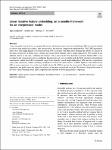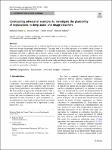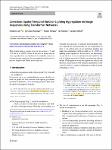Search
Author
- Jorgensen, Ed (3)
- McFadyen, Ron (3)
- Nora, El-Rashidy (3)
- Christian, Homeyer (2)
- next >
Subject
- programming (10)
- Open Access (8)
- Java (7)
- Programming (7)
- next >
Date issued
- 2020 - 2025 (293)
- 2010 - 2019 (39)
- 2000 - 2009 (2)
- 1999 - 1999 (1)
Has File(s)
- true (335)
Search Results
A new ensemble framework for an interpretable model called linear iterative feature embedding (LIFE) has been developed to achieve high prediction accuracy, easy interpretation, and efficient computation simultaneously. The LIFE algorithm is able to fit a wide single-hidden-layer neural network (NN) accurately with three steps: defining the subsets of a dataset by the linear projections of neural nodes, creating the features from multiple narrow single-hidden-layer NNs trained on the different subsets of the data, combining the features with a linear model. The theoretical rationale behind LIFE is also provided by the connection to the loss ambiguity decomposition of stack ensemble methods. Both simulation and empirical experiments confirm that LIFE consistently outperforms directly... |
While the evolution of mobile computing is experiencing considerable growth, it is at the same time seriously threatened by the limitations of battery technology, which does not keep pace with the evergrowing increase in energy requirements of mobile applications. Yet, with the limits of human perception and the diversity of requirements that individuals may have, a question arises of whether the effort should be made to always deliver the highest quality result to a mobile user? In this work we investigate how a user’s physical activity, the spatial/temporal properties of the video, and the user’s personality traits interact and jointly influence the minimal acceptable playback resolution. We conduct two studies with 45 participants in total and find out that the minimal acceptable... |
Ensembles are among the state-of-the-art in many machine learning applications. With the ongoing integration of ML models into everyday life, e.g., in the form of the Internet of Things, the deployment and continuous application of models become more and more an important issue. Therefore, small models that offer good predictive performance and use small amounts of memory are required. Ensemble pruning is a standard technique for removing unnecessary classifiers from a large ensemble that reduces the overall resource consumption and sometimes improves the performance of the original ensemble. Similarly, leaf-refinement is a technique that improves the performance of a tree ensemble by jointly re-learning the probability estimates in the leaf nodes of the trees, thereby allowing for ... |
Given the rise of deep learning and its inherent black-box nature, the desire to interpret these systems and explain their behaviour became increasingly more prominent. The main idea of so-called explainers is to identify which features of particular samples have the most influence on a classifier’s prediction, and present them as explanations. Evaluating explainers, however, is difficult, due to reasons such as a lack of ground truth. In this work, we construct adversarial examples to check the plausibility of explanations, perturbing input deliberately to change a classifier’s prediction. This allows us to investigate whether explainers are able to detect these perturbed regions as the parts of an input that strongly influence a particular classification. Our results from the audi... |
We consider a generic type of nonlinear Hammerstein-type integral equations with the particularity of having non-differentiable kernel of Nemystkii type. So, in order to solve it we consider a uniparametric family of iterative processes derivative free, with the main advantage that for a special value of the involved parameter the iterative method obtained coincides with Newton’s method, that is due to the fact of evaluating the divided difference operator when the two values are the same. We perform a qualitative convergence study by choosing an auxiliary point, that allow us to obtain the existence and separation of solutions of the given equation, that is, local and semilocal convergence balls can be obtained. |
In our work, we go in a similar direction as we robustly estimate the global sun direction and other lighting parameters (Lalonde & Matthews, 2014) by fusing estimates both from the spatial and temporal domains. |
With the remarkable increase in the number of scientific entities such as publications, researchers, and scientific topics, and the associated information overload in science, academic recommender systems have become increasingly important for millions of researchers and science enthusiasts. However, it is often overlooked that these systems are subject to various biases. In this article, we first break down the biases of academic recommender systems and characterize them according to their impact and prevalence. In doing so, we distinguish between biases originally caused by humans and biases induced by the recommender system. Second, we provide an overview of methods that have been used to mitigate these biases in the scholarly domain. Based on this, third, we present a framework ... |
This paper presents the first attribute-based signature (ABS) scheme supporting signing policies representable by Turing machines (TM), based on well-studied computational assumptions. Our work supports arbitrary TMs as signing policies in the sense that the TMs can accept signing attribute strings of unbounded polynomial length and there is no limit on their running time, description size, or space complexity. Moreover, we are able to achieve input-specific running time for the signing algorithm. All other known expressive ABS schemes could at most support signing policies realizable by either arbitrary polynomial-size circuits or TMs having a pre-determined upper bound on the running time. |
In this study, we present an objective, replicable methodology to identify trendy journals in any consolidated discipline. Trendy journals are those most read by authors who are currently publishing within the scope of the discipline. Trendy journal lists differ from consolidated lists of top core journals; the latter are very stable over time, mainly reflecting reputational factors, whereas the former reveal current influences not yet captured by studies based on bibliometric indicators or expert surveys. We apply our methodology to identify trendy journals among 167 titles indexed in the Web of Science category of the Information Science & Library Science (LIS) research area. |
This work proposes and compare two different approaches for real-time human action recognition (HAR) from raw depth video sequences. Both proposals are based on the convolutional long short-term memory unit, namely ConvLSTM, with differences in the architecture and the long-term learning. The former uses a video-length adaptive input data generator (stateless) whereas the latter explores the stateful ability of general recurrent neural networks but is applied in the particular case of HAR. This stateful property allows the model to accumulate discriminative patterns from previous frames without compromising computer memory. Furthermore, since the proposal uses only depth information, HAR is carried out preserving the privacy of people in the scene, since their identities can not be ... |










